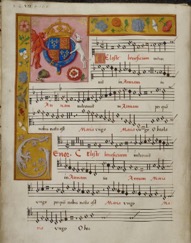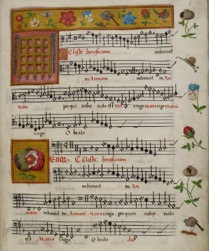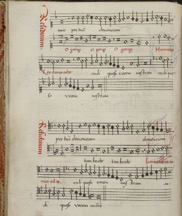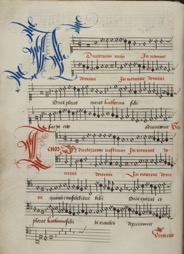I am absolutely thrilled to share with you the first of a seven part series of guest posts about the musical lives of Henry VIII and his queen consorts by Brooke C. Little. Each new instalment will be published around the 5th of each month and conclude with Henry VIII in August. A very big thank you to Brooke for taking time out from her doctoral studies to write these fascinating posts.
THE MUSICAL LIVES OF HENRY’S SIX WIVES
Part 1
CATALINA DE ARAGONIA- MUSICA, LA GRANADA Y CANCIONES DE PÉRDIDA
NIÑOS
By Brooke C. Little
Katherine of Aragon was arguably one of the most musical queens to sit on the English throne. She was an accomplished instrumentalist, active singer, graceful dancer, great appreciator as well as patron-both for the larger court as well as cultivating a musical circle amongst the small community of her attending ladies.
Katherine’s mother Isabella emphasized her daughter’s education, and singled out music as one of the most important components of Katherine’s training as a princess and future queen of England. The musical education Isabella gave Katherine was not only to prepare her for the role of female monarch of Britain, but was meant to showcase her daughter’s physical wellness and therefore her fitness to bear children.
All of Isabella’s children were said to have enjoyed singing. Katherine would have learned to play instruments like the lute, virginals, and possibly the monochord. In addition to her musical training in both vocal and instrumental music, another vital component of Katherine’s education was her instruction in dance. Katherine’s demonstration of graceful dancing would have testified to possible future suitors her health and fecundity. One of Katherine’s first tasks upon arriving to England in 1501 was a public dance performance and the demonstration of her Spanish ladies’ musical talents through singing.
In 1501 Katherine was presented formally to her future father-in-law Henry VII and was officially contracted in her marriage to Arthur, Prince of Wales. The Receyt of Ladie Kathryn details some of the first musical experiences the young couple would share:
“[…] with the Lord Prince visited the Ladie in her owne chamber. And then she and her ladies let call their mynstrelles and with right goodly behavior and manner they slacid theymself with the disportes of daunsyng.”
As Katherine’s life role changed from betrothed to married, her musical involvement transformed as well. Katherine moved from a musical role where she had to prove her fecundity through performance, to that of an active audience member and musical host.
Few items demonstrate Katherine’s sole purpose in life as mother to the nation and heir to the throne, better than Katherine’s own personal symbol, the pomegranate. The Royal MS 8G VII is a music manuscript that reinforces Katherine’s responsibility to provide England with an heir to the throne, through its depiction of Katherine’s symbol of the pomegranate, its fertility themed texts, and its polyphonic settings of Marian praise.
The British Library places the manuscripts origin in the year 1513, although it is unclear whether that is the date of presentation to Katherine or the manuscripts’ creation in Brussels.
From January 1510 until November 1518 Queen Katherine underwent a series of failed pregnancies including yet another loss of a male heir, Prince Henry in September 1513. These dates help to place the songbook’s date in context with Katherine’s own personal reproductive journey.
The second piece of Katherine’s songbook best communicates the grief Katherine must have felt in losing three potential males heirs. The work Adiutorium Nostrum by Antoine de Févin was originally composed for Anne of Brittany. However, in this particular piece Anne’s name is replaced with Katherine, and Louis becomes Henry. The translation of the Latin text reads;
Our help is in the name of the Lord. Who will not be?confessed to you? Katherine prays, weeps, and pleads for?herself; praying, we beseech you, act that we might be?helped quickly by your clemency. O most blessed George,?King Henry cries to you; I beg you, hear our voice.? [1]
The text of this piece conveys an immense depth of loss. Words like “prays”, “weeps”, “beseech”, “help”, “beg” and even “cries” are a few verbs that communicate desperation. Each of these powerful words are reinforced with altering melismatic passages between the voices. For example, the countertenor glides through the word exorat, or pleads, longer than any other word in the section. In the following page, the word clemencia, mercy or clemency, is brought out from the texture through repetition. The tenor line repeats the word twice as if to communicate true begging for relief.
The powerful characters portrayed and the coloration of ink used in the piece also reinforces the grief endured at the loss of future heirs. St. George, the patron saint of England, is called upon to aid the King and Queen in their hour of despair. Every miscarriage on Katherine’s part represented an uncertain political future for England and precarious circumstances for Katherine personally.
Link to Alamire’s performance of Adiutorium Nostrum
https://www.youtube.com/watch?v=FVtzwew7Ekc
Source Notes:
1. Alamire, The Spy’s Choirbook-Petrus Alamire & the Court of Henry VIII. English Cornett and Sackbutt Ensemble. David Skinner. CCLCD712, 2014.CD. Liner notes by David Skinner and Gawain Glenton.
Beer, Michelle L., “Practices and Performances of Queenship: Catherine of Aragon and Margaret Tudor 1503-1533” (PhD Diss., University of Illinois- Champaigne Urbana, 2014).
Kipling Gordon, ed., The Receyt of Ladie Kateryne (Oxford: Oxford University Press, 1990).
Knighton, Tess, “The Spanish Court of Ferdinand and Isabella,” in The Renaissance From the 1470s to the End of the 16th Century. ed., Fenlon, Iain. (New Jersey: Prentice Hall, 1989).
The Western Manuscripts Collection. Kings MS 8 G VII. British Library.
Williams Patrick, Katherine of Aragon (Amberly Publishing, Gloucestershire, 2013).
About the Author
 Brooke Little is a researcher, writer and music instructor living in the United States with her husband and two cats. She graduated in 2001 with a BM in vocal performance and in 2008 with an MME in Music Education from the University of Missouri-Columbia. She has recently completed her second masters degree in Musicology from the Conservatory at the University of Missouri- Kansas City. Her masters thesis entitled “The Musical Lives of Henry VIII’s Six Wives” was completed in December 2017. Brooke has conducted research at the Royal College of Music London, Lambeth Palace Library, the British Library, and the National Archives at Kew. She presented her work on Jane Seymour and Anne of Cleves at the Sixteenth Century Society Conference in Milwaukee, WI in October 2017. She plans to continue her study of Tudor women’s musical lives through doctoral study. Brooke is committed to re-telling the story of each queen through the perspective of their individual musical involvement and contribution.
Brooke Little is a researcher, writer and music instructor living in the United States with her husband and two cats. She graduated in 2001 with a BM in vocal performance and in 2008 with an MME in Music Education from the University of Missouri-Columbia. She has recently completed her second masters degree in Musicology from the Conservatory at the University of Missouri- Kansas City. Her masters thesis entitled “The Musical Lives of Henry VIII’s Six Wives” was completed in December 2017. Brooke has conducted research at the Royal College of Music London, Lambeth Palace Library, the British Library, and the National Archives at Kew. She presented her work on Jane Seymour and Anne of Cleves at the Sixteenth Century Society Conference in Milwaukee, WI in October 2017. She plans to continue her study of Tudor women’s musical lives through doctoral study. Brooke is committed to re-telling the story of each queen through the perspective of their individual musical involvement and contribution.






















thanks you can’t wait to read next months release
This is absolutely fascinating! I cannot wait to read the rest of the series as it posts this year.
So interesting!! Thank you for sharing your fascinating
research!
Thank you so much. I really enjoyed learning this about The first of Henry’s Queens.